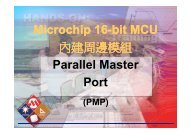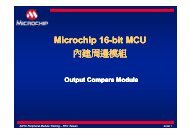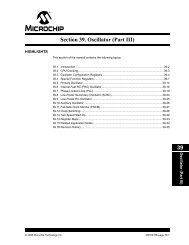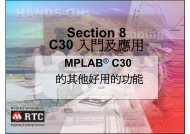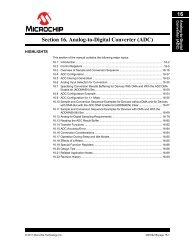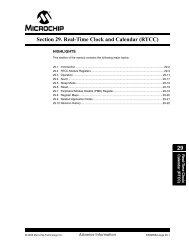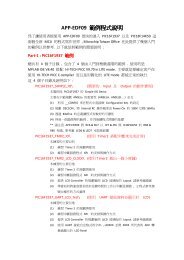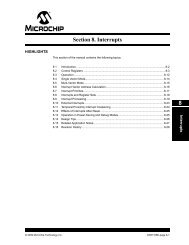Section 4. Program Memory - Microchip Taiwan
Section 4. Program Memory - Microchip Taiwan
Section 4. Program Memory - Microchip Taiwan
Create successful ePaper yourself
Turn your PDF publications into a flip-book with our unique Google optimized e-Paper software.
dsPIC33E/PIC24E Family Reference Manual<strong>4.</strong>2 CONTROL REGISTERSRegister 4-1:TBLPAG: Table Page RegisterU-0 U-0 U-0 U-0 U-0 U-0 U-0 U-0— — — — — — — —bit 15 bit 8R/W-0 R/W-0 R/W-0 R/W-0 R/W-0 R/W-0 R/W-0 R/W-0TBLPAGbit 7 bit 0Legend:R = Readable bit W = Writable bit U = Unimplemented bit, read as ‘0’-n = Value at POR ‘1’ = Bit is set ‘0’ = Bit is cleared x = Bit is unknownbit 15-8 Unimplemented: Read as ‘0’bit 7-0 TBLPAG: Table Address Page bitsThe 8-bit Table Address Page bits are concatenated with the W register to form a 23-bit effectiveprogram memory address plus a Byte Select bit.Register 4-2: DSRPAG: Data Space Read Page Register (1,2)U-0 U-0 U-0 U-0 U-0 U-0 R/W-0 R/W-0— — — — — — DSRPAGbit 15 bit 8R/W-0 R/W-0 R/W-0 R/W-0 R/W-0 R/W-0 R/W-0 R/W-1DSRPAGbit 7 bit 0Legend:R = Readable bit W = Writable bit U = Unimplemented bit, read as ‘0’-n = Value at POR ‘1’ = Bit is set ‘0’ = Bit is cleared x = Bit is unknownbit 15-10 Unimplemented: Read as ‘0’bit 9-0 DSRPAG: Data Space Read Page Pointer bitsNote 1: When DSRPAG = 0x000, attempts to read from the paged DS window will cause an address error trap.2: DSRPAG is reset to 0x001.DS70613B-page 4-4© 2010 <strong>Microchip</strong> Technology Inc.
<strong>Section</strong> <strong>4.</strong> <strong>Program</strong> <strong>Memory</strong><strong>4.</strong>3 PROGRAM COUNTERThe PC increments by two with the Least Significant bit (LSb) set to ‘0’ to provide compatibilitywith data space addressing. Sequential instruction words are addressed in the 4M programmemory space by PC. Each instruction word is 24 bits wide.The LSb of the program memory address (PC) is reserved as a Byte Select bit for programmemory accesses from data space, that use <strong>Program</strong> Space Visibility (PSV) or table instructions.For instruction fetches via the PC, the Byte Select bit is not required, so PC is always set to‘0’. For more information on the PSV mode of operation, see <strong>4.</strong>5 “<strong>Program</strong> Space Visibilityfrom Data Space”.Figure 4-2 illustrates an instruction fetch example. Note that incrementing PC by ‘1’ isequivalent to adding 2 to PC.Figure 4-2:Instruction Fetch Example24 bits23 User+1 (1)Space23Instruction0x00000024InstructionLatch<strong>Program</strong> Counter 022 00x7FFFFENote 1:An increment of ‘1’ to PC is equivalent to PC+2.4<strong>Program</strong> <strong>Memory</strong>© 2010 <strong>Microchip</strong> Technology Inc. DS70613B-page 4-5
dsPIC33E/PIC24E Family Reference Manual<strong>4.</strong>4 PROGRAM MEMORY ACCESS USING TABLE INSTRUCTIONSThe TBLRDx and TBLWTx instructions offer a direct method of reading or writing the leastsignificant word (lsw) and the Most Significant Byte (MSB) of any address within program spacewithout going through data space, which is preferable for some applications.<strong>4.</strong><strong>4.</strong>1 Table Instruction SummaryA set of table instructions is provided to move byte- or word-sized data between program spaceand data space. The table read instructions are used to read from the program memory spaceinto data memory space. The table write instructions allow data memory to be written to theprogram memory space using write latches.Note:Detailed code examples using table write instructions can be found in <strong>Section</strong>5. “Flash <strong>Program</strong>ming” (DS70609).The four available table instructions are:• TBLRDL: Table Read Low• TBLWTL: Table Write Low• TBLRDH: Table Read High• TBLWTH: Table Write HighFor table instructions, program memory can be regarded as two 16-bit, word-wide addressspaces residing side by side, each with the same address range (as illustrated in Figure 4-3).This allows program space to be accessed as byte or aligned word addressable, 16-bit-wide,64-Kbyte pages (i.e., same as data space).TBLRDL and TBLWTL access the least significant data word of the program memory, and TBLRDHand TBLWTH access the upper word. Because program memory is only 24 bits wide, the upperbyte from this latter space does not exist, although it is addressable. It is, therefore, termed the“phantom” byte.Figure 4-3:High and Low Address Regions for Table OperationsPC Address0x0001000x0001020x0001040x00010623168000000000000000000000000000000000<strong>Program</strong> <strong>Memory</strong>‘Phantom’ Byte(Read as ‘0’)‘HIGH’ Table Address Range‘LOW’ Table Address RangeNote:The TBLPAG register can be written using the MOVPAG #lit8, TBLPAG instructionor the MOVPAGW Wn, TBLPAG instruction. Refer to the “16-bit MCU and DSC<strong>Program</strong>mer’s Reference Manual” (DS70157) for details.DS70613B-page 4-6© 2010 <strong>Microchip</strong> Technology Inc.
dsPIC33E/PIC24E Family Reference Manual<strong>4.</strong><strong>4.</strong>4 <strong>Program</strong> <strong>Memory</strong> High Word AccessThe TBLRDH and TBLWTH instructions are used to access the upper 8 bits of the programmemory data. Figure 4-6 illustrates how these instructions also support Word or Byte Accessmodes for orthogonality, but the high byte of the program memory data will always return ‘0’.Figure 4-6:<strong>Program</strong> Data Table Access (Upper 8 bits)TBLRDH.WPC Address2316800x000100000000000x000102000000000x000104000000000x00010600000000TBLRDH.B (Wn = 0)<strong>Program</strong> <strong>Memory</strong>‘Phantom’ Byte(Read as ‘0’)TBLRDH.B (Wn = 1)DS70613B-page 4-8© 2010 <strong>Microchip</strong> Technology Inc.
<strong>Section</strong> <strong>4.</strong> <strong>Program</strong> <strong>Memory</strong>Figure 4-7:Table <strong>Memory</strong> MapInstruction Executed =TBLRDL, TBLRDH, TBLWTL or TBLWTH(Table Access Enabled)TBLRDH orTBLWTH(MS-ByteAccess Enabled)TBLRDL orTBLWTL(LS-WordAccess Enabled)24-bit<strong>Program</strong> Space Address[TBLPAG:Wn]0x000000TABLE PAGE0x00TABLE PAGE0x000x010000TABLE PAGE0x01TABLE PAGE0x010x020000TABLE PAGE0x02TABLE PAGE0x024TABLE PAGE0xFDTABLE PAGE0xFETABLE PAGE0xFDTABLE PAGE0xFE0xFD00000xFE0000<strong>Program</strong> <strong>Memory</strong>0xFF0000TABLE PAGE0xFFTABLE PAGE0xFF0xFFFFFE© 2010 <strong>Microchip</strong> Technology Inc. DS70613B-page 4-9
<strong>Section</strong> <strong>4.</strong> <strong>Program</strong> <strong>Memory</strong>Example 4-2:#include Using MPLAB ® C Compiler to Access <strong>Program</strong> <strong>Memory</strong>_FOSCSEL(FNOSC_FRC);_FOSC(FCKSM_CSECMD & OSCIOFNC_OFF & POSCMD_NONE);_FWDT(FWDTEN_OFF);int prog_data[10] __attribute__((space(prog),fillupper(0xAB))) = {0x0000,0x1111, 0x2222, 0x3333, 0x4444, 0x5555, 0x6666, 0x7777, 0x8888, 0x9999};unsigned int lowWord[10], highWord[10];unsigned int tableOffset, loopCount;int main(void){TBLPAG = __builtin_tblpage (prog_data);tableOffset = __builtin_tbloffset (prog_data);/* Read all 10 constants into the lowWord and highWord arrays */for (loopCount = 0; loopCount < 10; loopCount ++){lowWord[loopCount] = __builtin_tblrdl (tableOffset);highWord[loopCount] = __builtin_tblrdh (tableOffset);tableOffset +=2;}}while(1);4<strong>Program</strong> <strong>Memory</strong>© 2010 <strong>Microchip</strong> Technology Inc. DS70613B-page 4-11
dsPIC33E/PIC24E Family Reference Manual<strong>4.</strong>5 PROGRAM SPACE VISIBILITY FROM DATA SPACEThe upper 32 Kbytes of the dsPIC33E/PIC24E data memory address space can optionally bemapped into any 16K word program space page. The PSV mode of operation providestransparent access of stored constant data from X data space without the need to use specialinstructions (i.e., TBLRD, TBLWT instructions).<strong>4.</strong>5.1 PSV ConfigurationThe dsPIC33E/PIC24E core extends the available data space through a paging scheme to makeit appear linear for pre- and post-modified effective addresses.The upper half of the base data space address (0x8000 to 0xFFFF) is used with the 10-bit DataSpace Read Page register (DSRPAG) to form a PSV address, and can address 8 Mbytes of PSVaddress space.The paged memory scheme provides access to multiple 32-Kbyte windows in the PSV memory.The PSV in the paged data memory space is illustrated in Figure 4-8.<strong>Program</strong> space (PS) can be read with a DSRPAG register of 0x200 or greater.Reads from PS are supported using the DSRPAG register. Writes to PS are not supported;therefore, the Data Space Write Page register (DSWPAG) is dedicated exclusively to data space(DS), including extended data space (EDS).For more information on the paged memory scheme refer to <strong>Section</strong> 3. “Data <strong>Memory</strong>”(DS70595).Note:The DSRPAG register can be written using the MOVPAG #lit10, DSRPAG instructionor the MOVPAG Wn, DSRPAG instruction. Refer to the “16-bit MCU and DSC<strong>Program</strong>mer’s Reference Manual” (DS70157) for details.DS70613B-page 4-12© 2010 <strong>Microchip</strong> Technology Inc.
<strong>Section</strong> <strong>4.</strong> <strong>Program</strong> <strong>Memory</strong>Figure 4-8:PSV <strong>Memory</strong> Map16-bitData SpaceAddress[EA]DSRPAG = 1(PSV Access Enabled)0x00000x8000SFR andNon-MappableData Space(PAGE 0)DSRPAG = 1 DSRPAG = 0(MS-ByteAccess Enabled)(LS-WordAccess Enabled)24-bit<strong>Program</strong> Space Address[0:DSRPAG:EA]0x000000MappableData SpacePSV PAGE0x300PSV PAGE0x2000xFFFF0x008000PSV PAGE0x301PSV PAGE0x2010x010000PSV PAGE0x302PSV PAGE0x2024PSV PAGE0x3FDPSV PAGE0x3FEPSV PAGE0x2FDPSV PAGE0x2FE0x7E80000x7F0000<strong>Program</strong> <strong>Memory</strong>0x7F8000PSV PAGE0x3FFPSV PAGE0x2FF0x7FFFFE© 2010 <strong>Microchip</strong> Technology Inc. DS70613B-page 4-13
dsPIC33E/PIC24E Family Reference ManualAllocating different page registers for read and write access allows the architecture to supportdata movement from different PSV to EDS pages, by configuring DSRPAG and DSWPAG toaddress PSV and EDS space, respectively. The data can be moved from PSV to EDS space bya single instruction.Figure 4-9 illustrates the generation of the PSV address. The 15 Least Significant bits (LSbs) ofthe PSV address are provided by the W register that contains the effective address. The MostSignificant bit (MSb) of the W register is not used to form the address. Instead, the MSb specifieswhether to perform a PSV access from program memory space or a normal access from the datamemory space. If the effective address of the W register is 0x8000 or greater, the data accesswill occur from program memory space, depending on the page selected by the DSRPAGregister. All data access occurs from the data memory when the effective address of theW register is less than 0x8000.Figure 4-9:PSV Address GenerationEAByteSelect1DSRPAGDSRPAGX (1)Select DSRPAGYfor PSVAddressDSRPAG= 1?NDSRPAG (2)1EAGenerateEDSaddress8 bits15 bits23-bit PS Effective AddressUser <strong>Program</strong> Space ReadNote 1: DSRPAG = 11 is used for accessing the Most Significant Byte (MSB), DSRPAG = 10 is used foraccessing the least significant word (lsw).2: PSV access is only performed if 0x200 ≤ DSRPAG ≤ 0x3FF.The remaining address bits are provided by the 8 LSb of the Read Data Space Page register(DSRPAG). The DSRPAG bits are concatenated with the 15 LSb of the W registerholding the effective address, and the MSb is forced to ‘0’, thereby forming a 24-bit programmemory address.Note:PSV can only be used to access values in the program memory space. Tableinstructions must be used to access values in the user configuration space.The LSb of the W register value is used as a Byte Select bit, which allows instructions using PSVto operate in Byte or Word mode.The PSV address is split into lsw and MSB. When DSRPAG = 0b10, the lsw 16 bits of the24-bit PS word can be accessed using PSV. When DSRPAG = 0b11, the MSB of the 24-bitPS word can be accessed using PSV. This is illustrated in Figure 4-10 and Figure 4-11. Therange of valid DSRPAG values for a lsw read starts at DSRPAG = 0x200 and the range of validDSRPAG values for a MSB read starts at DSRPAG = 0x300.DS70613B-page 4-14© 2010 <strong>Microchip</strong> Technology Inc.
<strong>Section</strong> <strong>4.</strong> <strong>Program</strong> <strong>Memory</strong>Figure 4-10:<strong>Program</strong> Space Visibility Operation lsw AccessDSRPAG0x2A2<strong>Program</strong> SpaceSelect PSV AccessDSRPAG = 1Data Space0x0000DSRPAG15X DataSpaceEA16EA = 015EA[15] = 1DSRPAG = 2'b100x800015DSRPAG = 08230x51000023 15 00xFFFFHigh/Low Select0x517FFF0x0010Data Read4<strong>Program</strong> <strong>Memory</strong>© 2010 <strong>Microchip</strong> Technology Inc. DS70613B-page 4-15
dsPIC33E/PIC24E Family Reference ManualFigure 4-11:<strong>Program</strong> Space Visibility Operation MSB AccessDSRPAG0x3A2<strong>Program</strong> SpaceSelect PSV AccessData SpaceDSRPAG = 10x0000DSRPAG15X DataSpaceEA16EA = 0EA = 1DSRPAG = 2'b11150x800015DSRPAG = 182323 15 00x5100000xFFFFHigh/Low Select0x517FFF0x0010Data Read<strong>4.</strong>5.2 PSV Mapping with X and Y Data SpaceThe Y data space is located outside the upper half of data space for most dsPIC33E/PIC24Evariants, such that the PSV area will map into X data space. The X and Y mapping affects theway PSV is used in algorithms.For example, the PSV mapping can be used to store coefficient data for Finite Impulse Response(FIR) filter algorithms. The FIR filter multiplies each value of a data buffer that contains historicalfilter input data with elements of a data buffer that contains constant filter coefficients. The FIRalgorithm is executed using the MAC instruction within a REPEAT loop. Each iteration of the MACinstruction prefetches one historical input value and one coefficient value to be multiplied in thenext iteration. One of the prefetched values must be located in X data memory space and theother must be located in Y data memory space.To satisfy the PSV mapping requirements for the FIR filter algorithm, the user application mustlocate the historical input data in the Y memory space, and the filter coefficients in X memoryspace.DS70613B-page 4-16© 2010 <strong>Microchip</strong> Technology Inc.
<strong>Section</strong> <strong>4.</strong> <strong>Program</strong> <strong>Memory</strong><strong>4.</strong>5.3 PSV TimingAll instructions that use PSV require five instruction cycles to complete execution.<strong>4.</strong>5.3.1 USING PSV IN A REPEAT LOOPInstructions that use PSV with Indirect Addressing mode using a post-modification offset of +2 or-2 within a REPEAT loop eliminate some of the cycle count overhead required for the instructionaccess from program memory. These instructions have an effective execution throughput of oneinstruction cycle per iteration. However the following iterations of the REPEAT loop will executein five instruction cycles:• First iteration• Instruction execution prior to exiting the loop due to an interrupt• Instruction execution upon re-entering the loop after an interrupt is servicedThe last iteration of the REPEAT loop will execute in six instruction cycles.If the PSV Addressing mode uses an offset range other than +2 or -2 within a REPEAT loop, fiveinstruction cycles are needed to execute each iteration of the loop.Note:Unlike PSV accesses, a TBLRDx instruction requires five instruction cycles for eachiteration.<strong>4.</strong>5.3.2 PSV AND INSTRUCTION STALLSFor more information about instruction stalls using PSV, refer to <strong>Section</strong> 2. “CPU” (DS70359).<strong>4.</strong>5.4 PSV Code ExamplesExample 4-3 illustrates how to create a buffer, and access the buffer in the compiler-managedPSV section. The auto_psv space is the compiler-managed PSV section. <strong>Section</strong>s greater than32K are allowed and automatically managed. By default, the compiler places all ‘const’ qualifiedvariables into the auto_psv space.When auto_psv is used, the compiler will save/restore the DSRPAG register dynamically, asneeded. The tool chain will arrange for the DSRPAG to be correctly initialized in the compilerrun-time startup code.Example 4-3: Compiler Managed PSV Access#include _FOSCSEL(FNOSC_FRC);_FOSC(FCKSM_CSECMD & OSCIOFNC_OFF & POSCMD_NONE);_FWDT(FWDTEN_OFF);const int m[5] __attribute__((space(auto_psv))) = {1, 2, 3, 4, 5};int x[5] = {10, 20, 30, 40, 50};int sum;int vectordot (int *, int *);int main(void){// Compiler-managed PSVsum = vectordot ((int *) m, x);while(1);}int vectordot (int *m, int *x){int i, sum = 0;for (i = 0; i < 5; i ++)sum += (*m++) * (*x++);return (sum);}4<strong>Program</strong> <strong>Memory</strong>Note:The auto_psv option must be used if the user application is using both PSV andEDS accesses on a device with more than 28 KB of RAM.© 2010 <strong>Microchip</strong> Technology Inc. DS70613B-page 4-17
dsPIC33E/PIC24E Family Reference ManualExample 4-4 illustrates buffer placement and access in the user-managed PSV section. The psvspace is the user-managed PSV section.Example 4-4: User Managed PSV Access#include _FOSCSEL(FNOSC_FRC);_FOSC(FCKSM_CSECMD & OSCIOFNC_OFF & POSCMD_NONE);_FWDT(FWDTEN_OFF);const int m[5] = {1, 2, 3, 4, 5};const int m1[5] __attribute__ ((address(0x10000))) = {2, 4, 6, 8, 10};const int m2[5] __attribute__ ((address(0x20000))) = {3, 6, 9, 12, 15};int x[5] = {10, 20, 30, 40, 50};int sum, sum1, sum2;int vectordot (int *, int *);int main(void){int temp;// Save original PSV page valuetemp = DSRPAG;DSRPAG = __builtin_psvpage (m1);sum1 = vectordot ((int *) m1, x);DSRPAG = __builtin_psvpage (m2);sum2 = vectordot ((int *) m2, x);// Restore original PSV page valueDSRPAG = temp;sum = vectordot ((int *) m, x);}while(1);int vectordot (int *m, int *x){int i, sum = 0;}for (i = 0; i < 5; i ++)sum += (*m++) * (*x++);return (sum);DS70613B-page 4-18© 2010 <strong>Microchip</strong> Technology Inc.
<strong>Section</strong> <strong>4.</strong> <strong>Program</strong> <strong>Memory</strong>Example 4-5 illustrates the placement of constant data in program memory, and accesses thisdata through the PSV data window using an assembly program.Example 4-5: PSV Code Example in Assembly.section .const, psvfib_data:.word 0, 1, 2, 3, 5, 8, 13; Start of code section.text.global __main__main:; Set DSRPAG to the page that contains the “fib_data” arrayMOVPAG #psvpage(fib_data), DSRPAG; Set up W0 as a pointer to “fib_data” through the PSV data windowMOV #psvoffset(fib_data), W0; Load the data values into registers W1 - W7MOV [W0++], W1MOV [W0++], W2MOV [W0++], W3MOV [W0++], W4MOV [W0++], W5MOV [W0++], W6MOV [W0++], W7done:BRA doneRETURN<strong>4.</strong>6 PROGRAM MEMORY WRITESThe dsPIC33E/PIC24E families of devices contain internal program Flash memory for executinguser code. There are two methods by which the user application can program this memory:• Run-Time Self-<strong>Program</strong>ming (RTSP)• In-Circuit Serial <strong>Program</strong>ming (ICSP)RTSP is accomplished using TBLWT instructions. ICSP is accomplished using the SPI interfaceand integral bootloader software. For further details on RTSP, refer to <strong>Section</strong> 5. “Flash<strong>Program</strong>ming” (DS70609). For further details on ICSP, refer to the “dsPIC33E/PIC24E Flash<strong>Program</strong>ming Specification” (DS70619), which can be obtained from the <strong>Microchip</strong> web site(www.microchip.com).<strong>4.</strong>7 PROGRAM MEMORY LOW-POWER MODEThe voltage regulator for the program Flash memory can be placed in Stand-by mode when thedevice is in Sleep mode, resulting in a significant reduction in device power-down current (IPD).When the VREGSF bit (RCON) is equal to ‘0’, the Flash memory voltage regulator goes intoStand-by mode during Sleep. When the VREGSF bit is equal to ‘1’, the Flash memory voltageregulator is active during Sleep mode.4<strong>Program</strong> <strong>Memory</strong>© 2010 <strong>Microchip</strong> Technology Inc. DS70613B-page 4-19
DS70613B-page 4-20 © 2010 <strong>Microchip</strong> Technology Inc.<strong>4.</strong>8 REGISTER MAPTable 4-1:A summary of the registers associated with <strong>Program</strong> <strong>Memory</strong> is provided in Table 4-1.<strong>Program</strong> <strong>Memory</strong> RegistersSFR Bit 15 Bit 14 Bit 13 Bit 12 Bit 11 Bit 10 Bit 9 Bit 8 Bit 7 Bit 6 Bit 5 Bit 4 Bit 3 Bit 2 Bit 1 Bit 0TBLPAG — — — — — — — — TBLPAG 0000DSRPAG — — — — — — DSRPAG 0001Legend: — = unimplemented, read as ‘0’. Shaded bits are not used in the operation of <strong>Program</strong> <strong>Memory</strong>.AllResetsdsPIC33E/PIC24E Family Reference Manual
<strong>Section</strong> <strong>4.</strong> <strong>Program</strong> <strong>Memory</strong><strong>4.</strong>9 RELATED APPLICATION NOTESThis section lists application notes that are related to this section of the manual. Theseapplication notes may not be written specifically for the dsPIC33E/PIC24E Product Families, butthe concepts are pertinent and could be used with modification and possible limitations. Thecurrent application notes related to the <strong>Program</strong> <strong>Memory</strong> module are:Title Application Note #No related application notes at this time.N/ANote:For additional Application Notes and code examples for the dsPIC33E/PIC24Efamilies of devices, visit the <strong>Microchip</strong> web site (www.microchip.com).4<strong>Program</strong> <strong>Memory</strong>© 2010 <strong>Microchip</strong> Technology Inc. DS70613B-page 4-21
dsPIC33E/PIC24E Family Reference Manual<strong>4.</strong>10 REVISION HISTORYRevision A (September 2009)This is the initial released version of this document.Revision B (July 2010)This revision includes the following updates:• All code examples have been updated (see Example 4-1 through Example 4-5)• Updated the <strong>Program</strong> <strong>Memory</strong> Map (see Figure 4-1)• Updated the first paragraph and the shaded note in <strong>4.</strong><strong>4.</strong>1 “Table Instruction Summary”• Added a shaded note after Figure 4-3 with information on writing to the TBLPAG register• Updated <strong>4.</strong><strong>4.</strong>2 “Table Address Generation”• Updated the second sentence in <strong>4.</strong><strong>4.</strong>3 “<strong>Program</strong> <strong>Memory</strong> Low Word Access”• Added the new figure Table <strong>Memory</strong> Map (see Figure 4-7) in <strong>4.</strong><strong>4.</strong>4 “<strong>Program</strong> <strong>Memory</strong>High Word Access”• Added a shaded note and updated the last paragraph in <strong>4.</strong>5.1 “PSV Configuration”• Updated the Paged Data <strong>Memory</strong> Space (see Figure 4-8)• Updated the PSV Address Generation (see Figure 4-9)• Changed the number of required instruction cycles from two to five throughout <strong>4.</strong>5.3 “PSVTiming”• Added a shaded note after Example 4-3 with information on using the auto_psv option• Added a reference to the “dsPIC33E/PIC24E Flash <strong>Program</strong>ming Specification” (DS70619)to <strong>4.</strong>6 “<strong>Program</strong> <strong>Memory</strong> Writes”DS70613B-page 4-22© 2010 <strong>Microchip</strong> Technology Inc.
Note the following details of the code protection feature on <strong>Microchip</strong> devices:• <strong>Microchip</strong> products meet the specification contained in their particular <strong>Microchip</strong> Data Sheet.• <strong>Microchip</strong> believes that its family of products is one of the most secure families of its kind on the market today, when used in theintended manner and under normal conditions.• There are dishonest and possibly illegal methods used to breach the code protection feature. All of these methods, to ourknowledge, require using the <strong>Microchip</strong> products in a manner outside the operating specifications contained in <strong>Microchip</strong>’s DataSheets. Most likely, the person doing so is engaged in theft of intellectual property.• <strong>Microchip</strong> is willing to work with the customer who is concerned about the integrity of their code.• Neither <strong>Microchip</strong> nor any other semiconductor manufacturer can guarantee the security of their code. Code protection does notmean that we are guaranteeing the product as “unbreakable.”Code protection is constantly evolving. We at <strong>Microchip</strong> are committed to continuously improving the code protection features of ourproducts. Attempts to break <strong>Microchip</strong>’s code protection feature may be a violation of the Digital Millennium Copyright Act. If such actsallow unauthorized access to your software or other copyrighted work, you may have a right to sue for relief under that Act.Information contained in this publication regarding deviceapplications and the like is provided only for your convenienceand may be superseded by updates. It is your responsibility toensure that your application meets with your specifications.MICROCHIP MAKES NO REPRESENTATIONS ORWARRANTIES OF ANY KIND WHETHER EXPRESS ORIMPLIED, WRITTEN OR ORAL, STATUTORY OROTHERWISE, RELATED TO THE INFORMATION,INCLUDING BUT NOT LIMITED TO ITS CONDITION,QUALITY, PERFORMANCE, MERCHANTABILITY ORFITNESS FOR PURPOSE. <strong>Microchip</strong> disclaims all liabilityarising from this information and its use. Use of <strong>Microchip</strong>devices in life support and/or safety applications is entirely atthe buyer’s risk, and the buyer agrees to defend, indemnify andhold harmless <strong>Microchip</strong> from any and all damages, claims,suits, or expenses resulting from such use. No licenses areconveyed, implicitly or otherwise, under any <strong>Microchip</strong>intellectual property rights.TrademarksThe <strong>Microchip</strong> name and logo, the <strong>Microchip</strong> logo, dsPIC,KEELOQ, KEELOQ logo, MPLAB, PIC, PICmicro, PICSTART,PIC 32 logo, rfPIC and UNI/O are registered trademarks of<strong>Microchip</strong> Technology Incorporated in the U.S.A. and othercountries.FilterLab, Hampshire, HI-TECH C, Linear Active Thermistor,MXDEV, MXLAB, SEEVAL and The Embedded ControlSolutions Company are registered trademarks of <strong>Microchip</strong>Technology Incorporated in the U.S.A.Analog-for-the-Digital Age, Application Maestro, CodeGuard,dsPICDEM, dsPICDEM.net, dsPICworks, dsSPEAK, ECAN,ECONOMONITOR, FanSense, HI-TIDE, In-Circuit Serial<strong>Program</strong>ming, ICSP, Mindi, MiWi, MPASM, MPLAB Certifiedlogo, MPLIB, MPLINK, mTouch, Octopus, Omniscient CodeGeneration, PICC, PICC-18, PICDEM, PICDEM.net, PICkit,PICtail, REAL ICE, rfLAB, Select Mode, Total Endurance,TSHARC, UniWinDriver, WiperLock and ZENA aretrademarks of <strong>Microchip</strong> Technology Incorporated in theU.S.A. and other countries.SQTP is a service mark of <strong>Microchip</strong> Technology Incorporatedin the U.S.A.All other trademarks mentioned herein are property of theirrespective companies.© 2010, <strong>Microchip</strong> Technology Incorporated, Printed in theU.S.A., All Rights Reserved.Printed on recycled paper.ISBN: 978-1-60932-386-8<strong>Microchip</strong> received ISO/TS-16949:2002 certification for its worldwideheadquarters, design and wafer fabrication facilities in Chandler andTempe, Arizona; Gresham, Oregon and design centers in Californiaand India. The Company’s quality system processes and proceduresare for its PIC ® MCUs and dsPIC ® DSCs, KEELOQ ® code hoppingdevices, Serial EEPROMs, microperipherals, nonvolatile memory andanalog products. In addition, <strong>Microchip</strong>’s quality system for the designand manufacture of development systems is ISO 9001:2000 certified.© 2010 <strong>Microchip</strong> Technology Inc. DS70613B-page 23
WORLDWIDE SALES AND SERVICEAMERICASCorporate Office2355 West Chandler Blvd.Chandler, AZ 85224-6199Tel: 480-792-7200Fax: 480-792-7277Technical Support:http://support.microchip.comWeb Address:www.microchip.comAtlantaDuluth, GATel: 678-957-9614Fax: 678-957-1455BostonWestborough, MATel: 774-760-0087Fax: 774-760-0088ChicagoItasca, ILTel: 630-285-0071Fax: 630-285-0075ClevelandIndependence, OHTel: 216-447-0464Fax: 216-447-0643DallasAddison, TXTel: 972-818-7423Fax: 972-818-2924DetroitFarmington Hills, MITel: 248-538-2250Fax: 248-538-2260KokomoKokomo, INTel: 765-864-8360Fax: 765-864-8387Los AngelesMission Viejo, CATel: 949-462-9523Fax: 949-462-9608Santa ClaraSanta Clara, CATel: 408-961-6444Fax: 408-961-6445TorontoMississauga, Ontario,CanadaTel: 905-673-0699Fax: 905-673-6509ASIA/PACIFICAsia Pacific OfficeSuites 3707-14, 37th FloorTower 6, The GatewayHarbour City, KowloonHong KongTel: 852-2401-1200Fax: 852-2401-3431Australia - SydneyTel: 61-2-9868-6733Fax: 61-2-9868-6755China - BeijingTel: 86-10-8528-2100Fax: 86-10-8528-2104China - ChengduTel: 86-28-8665-5511Fax: 86-28-8665-7889China - ChongqingTel: 86-23-8980-9588Fax: 86-23-8980-9500China - Hong Kong SARTel: 852-2401-1200Fax: 852-2401-3431China - NanjingTel: 86-25-8473-2460Fax: 86-25-8473-2470China - QingdaoTel: 86-532-8502-7355Fax: 86-532-8502-7205China - ShanghaiTel: 86-21-5407-5533Fax: 86-21-5407-5066China - ShenyangTel: 86-24-2334-2829Fax: 86-24-2334-2393China - ShenzhenTel: 86-755-8203-2660Fax: 86-755-8203-1760China - WuhanTel: 86-27-5980-5300Fax: 86-27-5980-5118China - XianTel: 86-29-8833-7252Fax: 86-29-8833-7256China - XiamenTel: 86-592-2388138Fax: 86-592-2388130China - ZhuhaiTel: 86-756-3210040Fax: 86-756-3210049ASIA/PACIFICIndia - BangaloreTel: 91-80-3090-4444Fax: 91-80-3090-4123India - New DelhiTel: 91-11-4160-8631Fax: 91-11-4160-8632India - PuneTel: 91-20-2566-1512Fax: 91-20-2566-1513Japan - YokohamaTel: 81-45-471- 6166Fax: 81-45-471-6122Korea - DaeguTel: 82-53-744-4301Fax: 82-53-744-4302Korea - SeoulTel: 82-2-554-7200Fax: 82-2-558-5932 or82-2-558-5934Malaysia - Kuala LumpurTel: 60-3-6201-9857Fax: 60-3-6201-9859Malaysia - PenangTel: 60-4-227-8870Fax: 60-4-227-4068Philippines - ManilaTel: 63-2-634-9065Fax: 63-2-634-9069SingaporeTel: 65-6334-8870Fax: 65-6334-8850<strong>Taiwan</strong> - Hsin ChuTel: 886-3-6578-300Fax: 886-3-6578-370<strong>Taiwan</strong> - KaohsiungTel: 886-7-536-4818Fax: 886-7-536-4803<strong>Taiwan</strong> - TaipeiTel: 886-2-2500-6610Fax: 886-2-2508-0102Thailand - BangkokTel: 66-2-694-1351Fax: 66-2-694-1350EUROPEAustria - WelsTel: 43-7242-2244-39Fax: 43-7242-2244-393Denmark - CopenhagenTel: 45-4450-2828Fax: 45-4485-2829France - ParisTel: 33-1-69-53-63-20Fax: 33-1-69-30-90-79Germany - MunichTel: 49-89-627-144-0Fax: 49-89-627-144-44Italy - MilanTel: 39-0331-742611Fax: 39-0331-466781Netherlands - DrunenTel: 31-416-690399Fax: 31-416-690340Spain - MadridTel: 34-91-708-08-90Fax: 34-91-708-08-91UK - WokinghamTel: 44-118-921-5869Fax: 44-118-921-582001/05/10DS70613B-page 24© 2010 <strong>Microchip</strong> Technology Inc.




